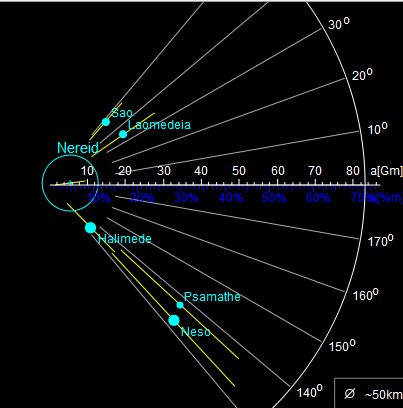Neso (pronounced /ˈniːsoʊ/ NEE-soh, or as in Greek Νησώ), also known as Neptune XIII, is the outermost irregular natural satellite of Neptune. It was discovered by Matthew J. Holman, Brett J. Gladman, et al. on August 14, 2002, though it went unnoticed until 2003.[4][5]

Irregular satellites of Neptune (*).
Neso orbits Neptune at a distance of more than 48 Gm (million km), making it the most distant known moon of any planet1. It follows a highly inclined and highly eccentric orbit illustrated on the diagram in relation to other irregular satellites of Neptune. The satellites above the horizontal axis are prograde, the satellites beneath it are retrograde. The yellow segments extend from the pericentre to the apocentre, showing the eccentricity.
Neso is about 60 km in diameter, and assuming the mean density of 1.5 g/cm3[6] its mass is estimated at 1.6 × 1017 kg.
Given the similarity of the orbit's parameters with Psamathe (S/2003 N 1), it was suggested that both irregular satellites could have a common origin in the break-up of a larger moon..[3]
Neso is named after one of the Nereides. Before the announcement of its name on February 3, 2007 (IAUC 8802), Neso was known by its provisional designation, S/2002 N 4.
1Such distances are of the order of magnitude of heliocentric distances of inner planets rather than moons; at apocenter the satellite is more than 72 Gm (72 million km) from the planet to compare with Mercury's aphelion of ~70 Gm!
References
1. ^ Discovery Circumstances from JPL
2. ^ Jacobson, R.A. (2008) NEP078 - JPL satellite ephemeris
3. ^ a b c S. Sheppard, D. Jewitt and J. Kleyna A Survey for "Normal" Irregular Satellites Around Neptune: Limits to Completeness, The Astronomical Journal, 132 (2006), pp. 171–176. Preprint.
4. ^ IAU Circular 8213
5. ^ M. Holman, JJ Kavelaars, B. Gladman, T. Grav, W. Fraser, D. Milisavljevic, P. Nicholson, J. Burns, V. Carruba, J.-M. Petit, P. Rousselot, O. Mousis, B. Marsden, R. Jacobson; Discovery of five irregular moons of Neptune, Nature, 430 (2004), pp. 865-867. Final preprint(pdf)
6. ^ Physical parameters from JPL
* Ephemeris from IAU
* Mean orbital parameters from JPL
External links
* Matthew Holman's Neptune's page
* David Jewitt's pages
* Scott Sheppard's pages
* Neso in Fiction
Retrieved from "http://en.wikipedia.org/"
All text is available under the terms of the GNU Free Documentation License

